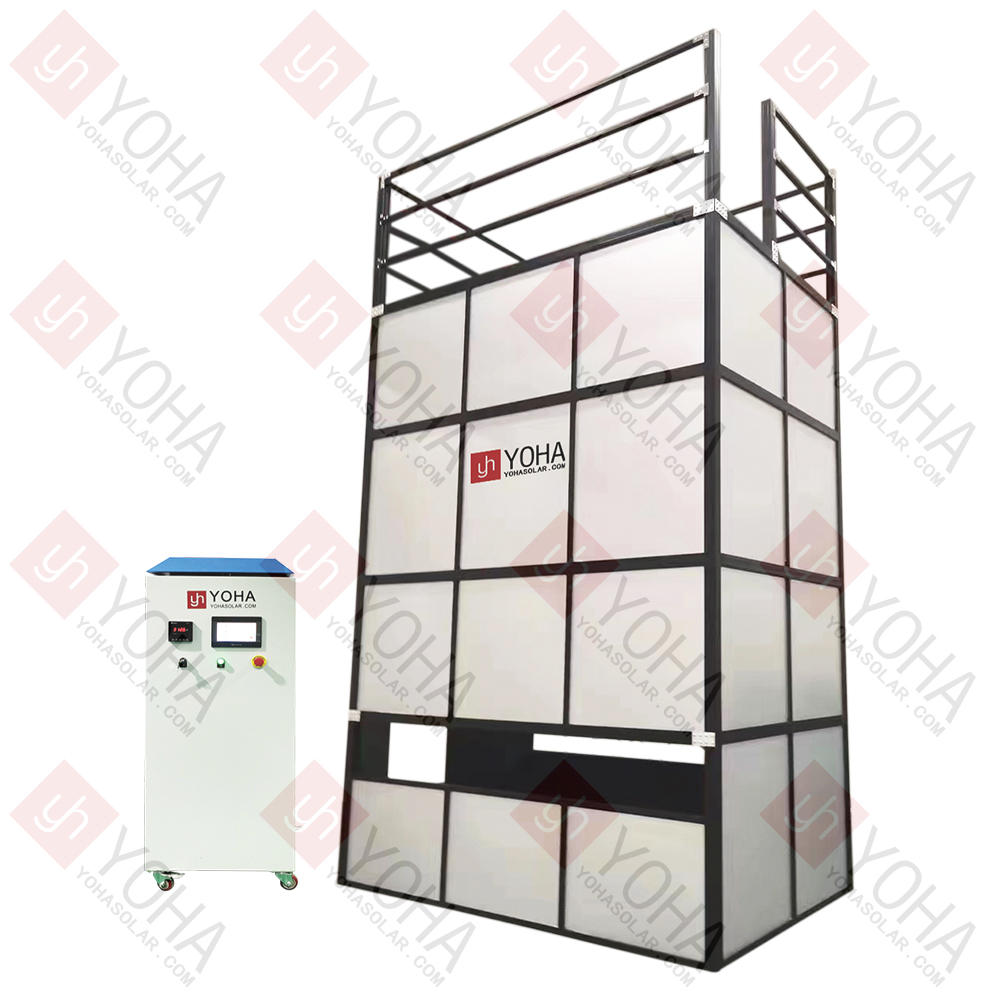Welcome to Wuhan Yoha Solar Technology Co., Ltd!
common problem
Site Map
Language:
 Chinese
Chinese
 English
English
Welcome to Wuhan Yoha Solar Technology Co., Ltd!
common problem
Site Map
Language:
 Chinese
Chinese
 English
English
The Upper Lighting Solar Panel IV Tester is a professional device that non-destructively measures the current-voltage (IV) characteristic curve of solar panels or modules under Standard Test Conditions (STC) by illuminating them with simulated sunlight from above. It accurately acquires core performance parameters such as maximum power point (Pmax), open-circuit voltage (Voc), short-circuit current (Isc), fill factor (FF), and conversion efficiency. It is primarily used for quality control, product sorting, and performance evaluation.

Top Illumination, Realistic Simulation: Features an overhead lighting design where the light source illuminates the module from above, more realistically simulating sunlight incidence scenarios (especially for framed, double-glass, or modules at specific installation angles), ensuring test conditions are highly consistent with real-world application environments.
Precise Measurement, Core Parameters: Non-destructively, rapidly, and accurately measures the complete current-voltage characteristic curve of solar modules under Standard Test Conditions (STC), and precisely calculates key performance parameters such as open-circuit voltage (Voc), short-circuit current (Isc), maximum power point (Pmax), fill factor (FF), and conversion efficiency.
Efficient & Non-Destructive, Safeguards Production: The testing process requires no flipping or moving of the module under test, significantly improving production line inspection efficiency and avoiding potential damage risks associated with handling and flipping during testing. Particularly suitable for high-speed online inspection and quality control on production lines.
Standardized & Reliable, Quality Assurance: Strictly adheres to international photovoltaic testing standards, providing reliable, repeatable, and traceable test data. It is a core device for module power sorting, factory acceptance testing, incoming material verification, and performance evaluation, effectively ensuring product quality and consistency.
| Item | Parameter |
|---|---|
| Model Specification | YHMT-HM-A+A+A+ |
| Light Source | Meets IEC 60904-9:2020 Spectral Requirements (Class A+) |
| Spectral Range | 300~1200nm |
| Irradiance | 1000W/m² (200~1200W/m²) |
| Light Intensity Non-Uniformity | ≤1% (A+) |
| Light Intensity Instability | ≤0.5% (A+) |
| Test Result Consistency | ≤0.5% |
| Electrical Parameter Measurement Error | ≤1% |
| Single Flash Pulse Width | 10~100ms |
| Effective Test Area | 2600*1600mm |
| Power Supply | 220V/50HZ |
| Equipment Dimensions | 3080×2520×5460mm |
1. PV Module Production & Quality Inspection: Serves as a core end-of-line inspection device for 100% full inspection or sampling testing of solar modules after production, precisely measuring power and other parameters for product power sorting, quality control, and factory certification, ensuring products meet datasheet promises.
2. Third-Party Testing & Certification: A key device for independent laboratories and certification bodies, used for performance verification, type testing, grid-connection certification, and incoming inspection of PV modules, providing objective, standardized test data reports to endorse product performance and reliability.
3. Power Plant Construction & O&M Assessment: Used for rapid, non-destructive testing of the actual output power of modules during large-scale PV power plant acceptance, pre-installation sampling, and operational performance troubleshooting, assessing potential initial light-induced degradation (LID) or defects to safeguard plant energy yield and investment returns.
4. R&D & Process Improvement: Provides a critical testing tool for PV material suppliers, module manufacturers, universities, and research institutes to evaluate the impact of new cell technologies, encapsulation materials, and production process improvements on final module performance, accelerating technology iteration and product optimization.
1. Intense Light Safety Protection: The device contains a high-brightness simulated light source. Never look directly into the light output port. All operators must wear specialized protective glasses to prevent permanent eye damage from intense light.
2. Light Source Calibration & Maintenance: The light source irradiance uniformity and spectral match must be calibrated regularly (as per manufacturer specifications and standard requirements). Replace the light source promptly when it reaches its end of life or performance degrades to ensure accurate testing benchmarks.
3. Management of Module Under Test Status: The module surface must be thoroughly cleaned (free of dust, dirt, water stains, and obstructions) before testing. It must be stabilized for at least 2-4 hours in a constant standard temperature environment (typically 25±2°C) to ensure measurement accuracy.
4. Strict Environmental Control Requirements: Testing must be conducted in a dedicated darkroom completely isolated from ambient light. The laboratory/workshop must maintain constant temperature (e.g., 25±1°C) and humidity (typically <60% RH) conditions to avoid environmental interference causing inaccurate test results.
5. Electrical Connection Reliability & System Calibration: Ensure test probes/fixtures have firm, non-oxidized contact with the module electrodes with very low contact resistance. Simultaneously, perform full system calibration (electrical parameters, temperature, light source) regularly according to standards (e.g., IEC 60904) to guarantee accurate and reliable data.
6. Standardized Operation & Understanding Limits: Strictly adhere to equipment operating procedures and safety regulations. Clearly understand that this device is primarily for measuring initial performance parameters (Pmax, Voc, Isc, FF, Eff) and cannot replace long-term reliability tests (e.g., PID, LID) or defect detection (e.g., EL). Analyze abnormal results in conjunction with other methods.
TOP
18086473422
MESSAGE
